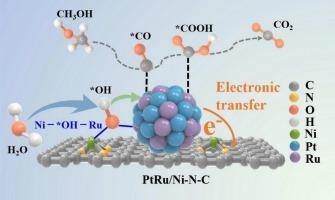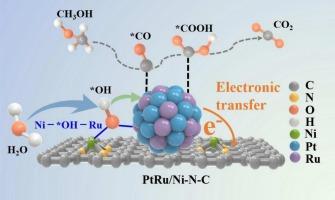Ni-N-C support boosts PtRu sub-nanocluster for effective methanol oxidation reaction
IF 13.2
1区 工程技术
Q1 ENGINEERING, CHEMICAL
引用次数: 0
Abstract
Exploring efficient and durable methanol oxidation reaction (MOR) electrocatalysts is crucial for the industrialization of direct methanol fuel cells. Herein, we designed MOR electrocatalyst of PtRu/Ni-N-C, in which PtRu nanoclusters (PtRu NCs) are loading on nitrogen-doping carbon support anchoring Ni single atoms (Ni-N-C). Compared with PtRu NCs and Pt/C, PtRu/Ni-N-C exhibits more excellent MOR activity with 2050 mA mgpt-1 and tougher anti-CO toxicity over 6000 s CA test, proving that the synergetic effect of nanoclusters and single atoms support enhance MOR activity and resistance to anti-CO toxicity. The fine spectroscopy analysis and density functional theory (DFT) calculations demonstrate that the strong metal-support interaction (SMSI) between nanoclusters and single atoms, facilitating the electron transfer of about 0.4 e from PtRu NCs to the Ni-N-C support, effectively reduces the d-band center of Pt to weaken the adsorption capacity of *CO and *COOH intermediates. Moreover, the synergistic sites derived PtRu NCs coupling Ni single atoms accelerate *OH adsorption, promoting the adjacent *CO removal. This work offers deep insight into the SMSI effect between nanoclusters and single atoms support to design the efficient Pt-based MOR electrocatalysts.


Ni-N-C载体促进PtRu亚纳米团簇有效的甲醇氧化反应
探索高效、耐用的甲醇氧化反应电催化剂是直接甲醇燃料电池产业化的关键。在此,我们设计了PtRu/Ni- n- c的MOR电催化剂,其中PtRu纳米簇(PtRu NCs)负载在氮掺杂碳载体锚定Ni单原子(Ni- n- c)上。与PtRu NCs和Pt/C相比,PtRu/Ni-N-C在2050 mA mgpt-1表现出更优异的MOR活性,在6000 s CA测试中表现出更强的抗co毒性,证明纳米簇和单原子载体的协同作用增强了MOR活性和抗co毒性。精细光谱分析和密度泛函理论(DFT)计算表明,纳米簇与单原子之间的强金属-载体相互作用(SMSI)促进了约0.4 e的电子从PtRu NCs转移到Ni-N-C载体,有效地降低了Pt的d带中心,削弱了*CO和*COOH中间体的吸附能力。此外,PtRu NCs偶联Ni单原子的协同位点加速了*OH的吸附,促进了相邻*CO的去除。本研究为纳米团簇和单原子支撑之间的SMSI效应提供了深入的见解,为设计高效的基于pt的MOR电催化剂提供了依据。
本文章由计算机程序翻译,如有差异,请以英文原文为准。
求助全文
约1分钟内获得全文
求助全文
来源期刊

Chemical Engineering Journal
工程技术-工程:化工
CiteScore
21.70
自引率
9.30%
发文量
6781
审稿时长
2.4 months
期刊介绍:
The Chemical Engineering Journal is an international research journal that invites contributions of original and novel fundamental research. It aims to provide an international platform for presenting original fundamental research, interpretative reviews, and discussions on new developments in chemical engineering. The journal welcomes papers that describe novel theory and its practical application, as well as those that demonstrate the transfer of techniques from other disciplines. It also welcomes reports on carefully conducted experimental work that is soundly interpreted. The main focus of the journal is on original and rigorous research results that have broad significance. The Catalysis section within the Chemical Engineering Journal focuses specifically on Experimental and Theoretical studies in the fields of heterogeneous catalysis, molecular catalysis, and biocatalysis. These studies have industrial impact on various sectors such as chemicals, energy, materials, foods, healthcare, and environmental protection.
 求助内容:
求助内容: 应助结果提醒方式:
应助结果提醒方式:


